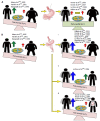Glucagon-like peptide 1 in the pathophysiology and pharmacotherapy of clinical obesity
- PMID: 28031776
- PMCID: PMC5155232
- DOI: 10.4239/wjd.v7.i20.572
Glucagon-like peptide 1 in the pathophysiology and pharmacotherapy of clinical obesity
Abstract
Though the pathophysiology of clinical obesity is undoubtedly multifaceted, several lines of clinical evidence implicate an important functional role for glucagon-like peptide 1 (GLP-1) signalling. Clinical studies assessing GLP-1 responses in normal weight and obese subjects suggest that weight gain may induce functional deficits in GLP-1 signalling that facilitates maintenance of the obesity phenotype. In addition, genetic studies implicate a possible role for altered GLP-1 signalling as a risk factor towards the development of obesity. As reductions in functional GLP-1 signalling seem to play a role in clinical obesity, the pharmacological replenishment seems a promising target for the medical management of obesity in clinical practice. GLP-1 analogue liraglutide at a high dose (3 mg/d) has shown promising results in achieving and maintaining greater weight loss in obese individuals compared to placebo control, and currently licensed anti-obesity medications. Generally well tolerated, provided that longer-term data in clinical practice supports the currently available evidence of superior short- and long-term weight loss efficacy, GLP-1 analogues provide promise towards achieving the successful, sustainable medical management of obesity that remains as yet, an unmet clinical need.
Keywords: Clinical obesity; Glucagon-like peptide 1; Glucagon-like peptide 1 analogues; Obesity pathophysiology.
Conflict of interest statement
Conflict-of-interest statement: Authors declare no conflict of interests for this article.
Figures

















References
-
- Organisation TWH. Global health observatory data; Situation and trends, 2016. Available from: http://www.who.int/gho/ncd/risk_factors/obesity_text/en/
-
- Organisation TWH. Obesity and Overweight fact sheet. Jun 2016. Available from: http://www.who.int/mediacentre/factsheets/fs311/en/
-
- Kelly T, Yang W, Chen CS, Reynolds K, He J. Global burden of obesity in 2005 and projections to 2030. Int J Obes (Lond) 2008;32:1431–1437. - PubMed
Publication types
LinkOut - more resources
Full Text Sources
Other Literature Sources
Research Materials

